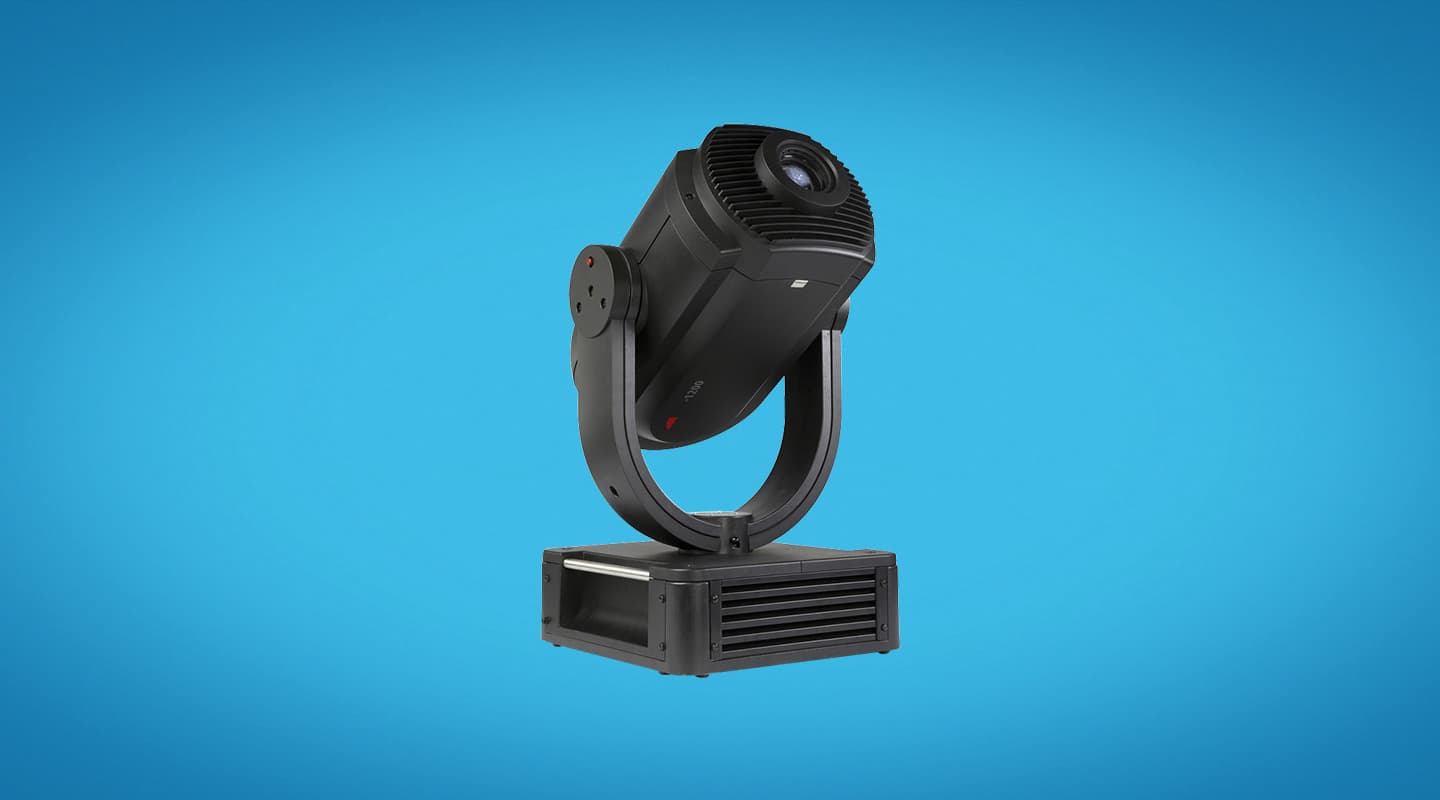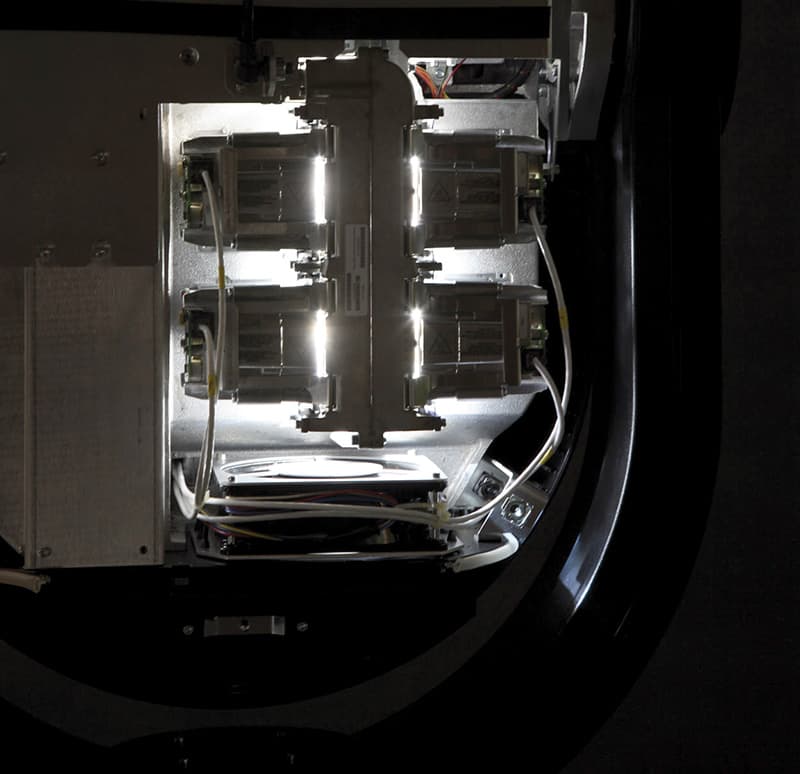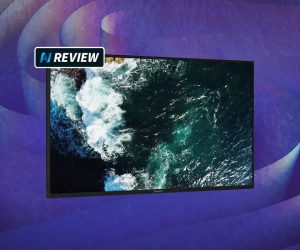
Review: Barco DML-1200
The world’s first, and so far only, Digital Moving Light.
Text:/ Paul Collison
The DML-1200 from Barco hit the market almost two years ago with much hoopla and fireworks. It was heralded as the first truly digital moving light. Descriptions such as ‘super bright moving light source’ and ‘high quality video projector’ were thrown around with gay abandon. What do these things mean? Was it? Is it?
I recently worked with eight DML-1200s on the National Games in China, where I learnt a lot about them in a short space of time. They were possibly out of their comfort zone in a massive stadium, but what better way to put something through its paces?
The DML has light source of four, 300w high-pressure mercury lamps driving a single chip DLP projector. You can run all four lamps or just one. This can help with extending lamp life which is great when you’re only doing positions or testing. Generally speaking, output with all four sources is similar to that of an average 1200w moving light fixture.
There are two configurations for the optical system: Light mode and Video mode.
In light mode the fixture projects only black and white images which can be tinted by the CMY colour system. The images can be static or video files. The ‘beam’ is round, I suppose to make you feel as though you are using a light rather than a projector.
In video mode, you guessed it; the DML becomes a certified video projector with a rectangular beam and a native resolution of 1440 x 1050 pixels. The specs say that output is increased by almost 20% when using light mode compared to video mode. This is definitely significant when using the fixture against top level 1200w and 1500w fixtures or for longer throws. Swapping between the two modes can take a second or two, and there is definitely a ‘lump’ in the transition.
THE LIGHTER SIDE
As a light, the DML has some great features. Firstly, because you are not limited to glass or metal gobos, you can create interesting aerial effects and ripples that are near impossible on traditional fixtures. Simply upload your own Photoshop doodle or After Effects animation and away you go. Greyscale logos, and even moving footage, are possible in light mode, but you are still limited to the greyscale.
A subtractive CMY colour mixing system allows for overall tinting and colour manipulation in both modes. There are mechanical shutters that Barco calls ‘Blanking Shutters’ although disappointingly, these shutters only work in parallel to the X and Y axis. They can not be angled as you would in a traditional profile, nor can the Blanking mechanism be rotated. Consequently this means that as long as your projection surfaces are offset on either the X or the Y axis then you are ok. Projecting off on both axes means these blanking shutters become effectively redundant. There is a mechanical iris, which helps control the diameter of the beam. Dimming is achieved through a nice balance of mechanical and digital dimming. This allows for a decent fade from 0% to 100% and most importantly means you get a true blackout and not the normal DLP grey out.
Pan and tilt aren’t fast by any definition. With a speed of just 68 degrees per second, it takes roughly seven seconds to get from one end of the pan to the other. One would assume that with fittings like these, you won’t (and can’t) be moving around too quickly.
A respectable 11° to 40° zoom range across both modes means that you don’t need a complement of lenses for different applications. It also makes the DML more versatile within the same show. A wider zoom would be nice of course, but this would undoubtedly require a much larger fixture and result in less output. Even at the longer throws in the stadium, 40°seemed a tad narrow at times, depending of course on content.
PRODUCT DETAILS
Price:
DML-1200 with Media Player $63,400
DML-1200 without Media Player $57,070
Barco Systems 03 96465833 or www.barco.com


THE (SLIGHTLY) DARKER SIDE
As a projection unit the DML has some limitations. The built in horizontal and vertical keystone correction is quite limited. I had my fittings spread around a stadium projecting at best 40° off axis. Whilst trying to soft edge blend in to each other, I could not correct the keystone enough without having to go to separate warping software. Using a warper tool to manipulate your media server is not uncommon, however it is a little surprising in a fitting that has 540° of pan and 270° of tilt, that you can’t keystone correct too far off axis. It seems, as long as the DML is fractionally off on either X or the Y axis then there is enough scope to edge blend and keystone correct. Stray too far off that line and you might get in trouble.
One other limiting factor is the lack of 16bit resolution in the rotation for media and ‘gobos’. At first thought this seems unnecessary, however in Jinan we used the DML-1200s to project fish swimming around the stadium floor. Inevitably we needed to rotate the fish in order to keep them swimming in a fashion akin to the direction the light was moving. With only 8bit rotation, you are left with just 255 points in 360°. Consequently, live rotation is out of the question as it becomes unbearably steppy. This would surely cause problems in a corporate environment, getting that all-important corporate logo straight.
There are a few options when using the DML in video mode. Onboard there are RGBHV and component inputs as well as HD/SD-SDI. There is also a genlock BNC to sync all external inputs. This gives all users the ability to employ separate media servers and simply use the DML to point the light in the right direction. To make things simple, Barco can deliver your DMLs with a version of the Green Hippo V3 media server installed internally. It has been slightly modified by Barco to run in two modes: Original Hippo Express mode or ‘Barco’ mode. There is a master layer, mask layer, and two media layers (four in Express mode). Barco have introduced a feature where you can change media on the same layer almost seamlessly. Having tried this, I would have to say that ‘seamlessly’ is not a word I would use to describe the transition. There aren’t many shows where I feel this type of transition could be used and not noticed. There is a noticeable glitch.
The media server is simple but effective. For use in the DML as a light I believe it is fine. Even as a media server for basic use the Hippo Express or Barco mode is fine. For complex media manipulation and management I would look to use a separate media server to manage media on DMLs.
WELL MANAGED MEDIA
One of the very cool things the DML-1200 media server does is with media management. Loading media requires either a PC (or mac) installed with the free management software, or a Barco Media Wing (which is essentially a tablet PC in a custom housing). The DML will transcode all media as it is imported and turn it in to what is fast becoming the standard codec for the media server industry: MPEG2 interlaced. The management software also allows the user to re-address fixtures and manage media. As soon as another DML-1200 is added in to the system, media can be spread to the new units simply and easily. Of course this does require a gigabit network between your fittings and one of the management tools. The upside being you can also then run your fittings on the same network via Artnet.
The management software has some other fancy features. There is an in-built warping tool for those more creative keystone challenges. Diagnostic tools are provided to ensure your system is working properly, and identify what may or may not need maintenance. As Barco would prefer you to buy the Media Wing rather than use the free software, they do limit your access to six fixtures at a time via the free software. In addition to the features of the manager software, the Media Wing allows for configuration and media management for 100 fittings, as well as an output preview for your devices.
So should you buy one? At 1.1m high and a whopping 72kg, the DML-1200 is not a fitting that will sit unobtrusively in most venues. As a light, it is intriguing and its possibilities are extensive. However, as most of us have learnt, extensive possibilities usually require much more preparation than limited ones. This is not really a fitting that can be thrown in a truck and used the next day without some sort of forethought about operational matters. As a projector, the DML is definitely limited, but still workable.
The upsides are that you aren’t limited by traditionally optics. Fading from one ‘gobo’ to the next is possible with a DML-1200 without a jump of the gobo wheel. Although it’s funny how that jump can sometimes be something you actually want!
FAMILY TIES
Unlike its new DL3/2 stepbrothers from High End, the DML does not have a camera on board. Whether this is good, bad or indifferent, I’m not sure. It’s apparent that for some people, the camera is a big thing. In the short term, there will always be a comparison to the DL family of products, simply as they are really the only competition to the DML. Although given that the DML-1200 is significantly brighter than the DL fixtures, there really is no competition in the DLP moving head market.
It will be interesting when the fallout of both the DML and DL ranges are compiled and then merged into a newer digital light under the Barco banner. Then we might start to see some advancement that will make the industry talk.
We will see more of them, and probably sooner rather than later. Certainly production companies keen to be at the forefront of technology are purchasing units. DML1200s are available for rent in most parts of the world. Time will tell just how popular they become with designers, and whether or not digital projection lights will become the norm.
One thing is certain: the DML-1200 is revolutionary. However the real question is, are we ready for that revolution?
















RESPONSES